
Using spreadsheet view
When you access a tab in GraceBlocks, the layout of the information presented is based on the view. If you are a builder, the default layout option is called spreadsheet view. This view presents information in a grid layout with columns and rows. Each row represents a record and each column represents a field. This view is essential for building on GraceBlocks. It's also great for extensive editing because it works very much like a spreadsheet, supporting actions like copy/paste. Builders can control if other users can have access to this view on a tab-by-tab basis by managing user roles and security access levels.
This article covers:
Viewing spreadsheet view
By default, when you click to access a tab in GraceBlocks, you will land on a view (quick, spreadsheet or possibly messaging view). Follow the steps below to access spreadsheet view.
| Step | Action | Visual |
| 1 |
Click to access any tab inside the block (other than the home tab). 🔔 The home tab is always reserved to share information prescribed by a builder when they design the block. |
 |
| 2 |
You may already be in spreadsheet view and if so your work is done! If not, proceed to step 3. |
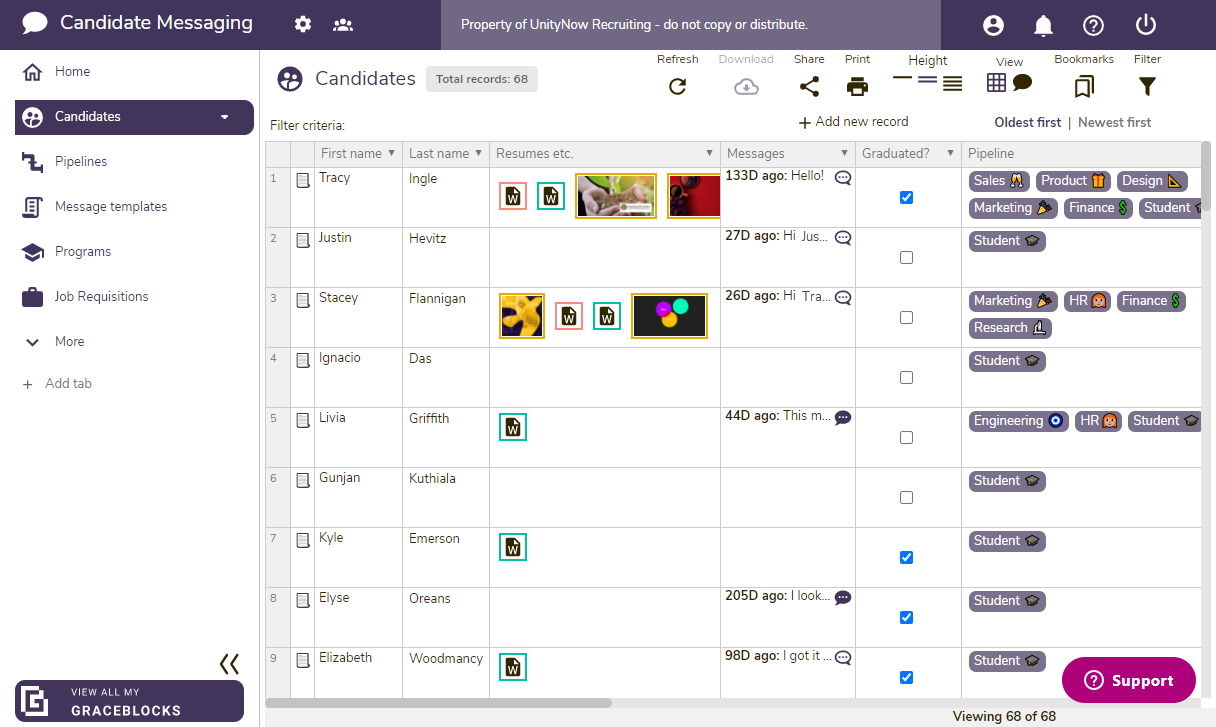 |
| 3 |
Click the spreadsheet view icon to toggle over to spreadsheet view. |
 |
Working in spreadsheet view
Working in spreadsheet view is largely like working in a spreadsheet. You can add data to rows directly and can interact using functions like copy and paste. For more information about this, see copy and paste tips.
A number of additional actions are also available in this view. Review the table below to understand the actions available from this page. The numbers in the illustration show where to find each action on the layout.
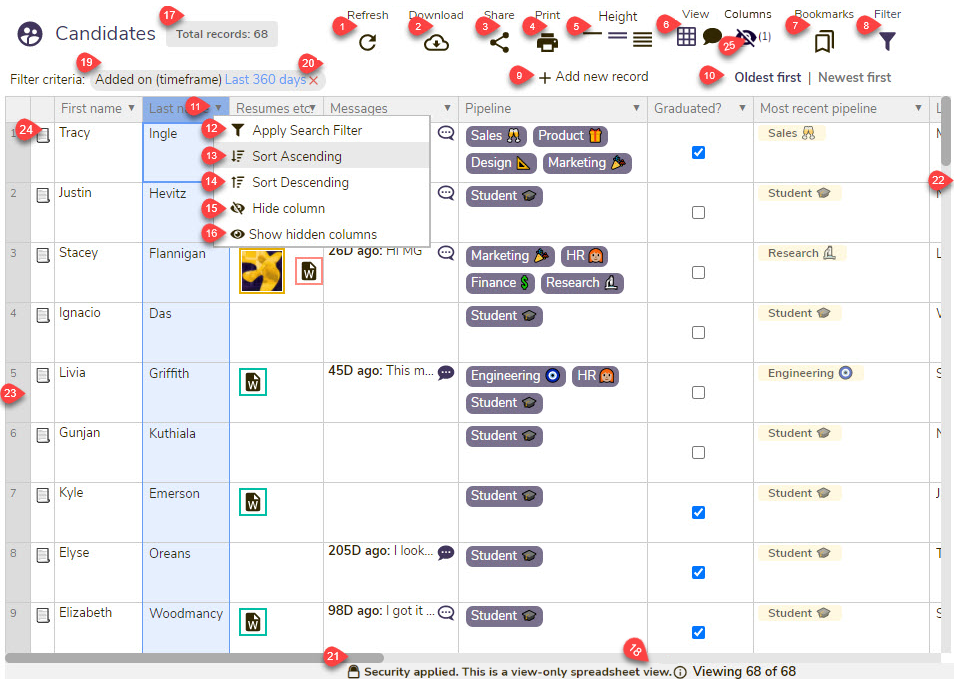
- Refresh: Click the Refresh icon to refresh the records on the page. This option might be useful, for example, if you have just sent a series of text messages and you want to see quickly which individuals have responded. Or, if other individuals are also using the data at the same time, clicking Refresh applies their latest updates to your view.
- Download: Click the Download icon to download records. Clicking this option generates a .csv file that includes all columns and rows in the view (inclusive of scrolling). To learn more, see downloading records. Builders can control access to this function on a tab-by-tab basis by leveraging user roles and security access levels.
- Share: Click the Share icon to share records with non-users of GraceBlocks. Clicking this option makes a sharable link available. To learn more, see sharing records. Builders can control access to this function on a tab-by-tab basis by leveraging user roles and security access levels.
- Print: The Print icon is not yet operational.
- Height: Select one of the three height options to determine how tall each record row will be. There are three icon options:
| Height | Icon | How records will display |
| Short |
 |
 |
| Medium |
 |
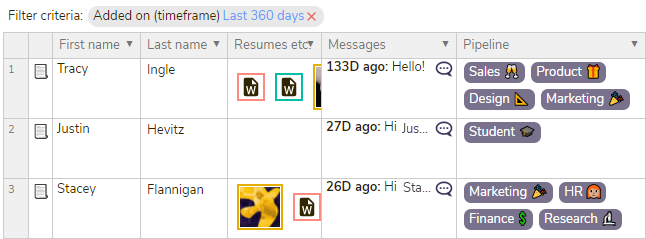 |
| Tall |
 |
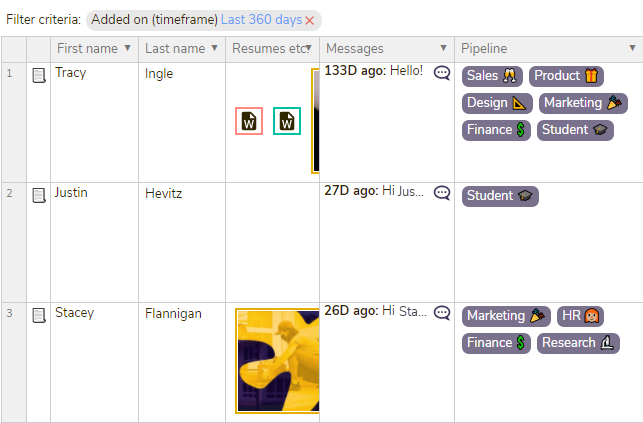 |
- View: Click one of the View options (if more than one is available) to select the view in which you work. This area is where you select the spreadsheet view, provided that more than one view type is available. If only one view type exists, this option and that associated icons do not display.
- Bookmarks: Click the Bookmarks icon to access and create bookmarks. A bookmark is essentially a saved version of the page, including any filters you applied, as well as column width, display, and order layout. When a user accesses a tab for the first time, the "public default" bookmark displays. To return to the original starting point, you can always click the Bookmarks icon and then select the bookmark that is set as the "public default." To learn more, see managing bookmarks.
- Filter: Click the Filter icon to filter records. From the search filters modal, you can choose filter fields, enter criteria, and then apply the filter criteria. To learn more, see filtering records.
- Add new records: Click + Add new record to add new records. Here's a preview of this button when you hover the cursor over it.
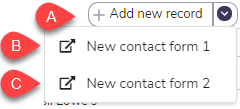
By default, there is a basic form behind the add new record button (A above). However, if a builder has created web forms and made them public, these additional forms can appear as dropdown options in addition to the main button (B & C above). The main Add new record button (A) can power the basic form offered by GraceBlocks, or — if the builder has set a "public default" — this button will launch that form instead. If multiple options exist (the button plus named forms below the button), follow the instructions of your builders regarding which option is best for you to use to create new records.
- Oldest first | Newest first: Sometimes it's easiest for the newest records to be at the top; other times, a chronological sort by date added works best. Click Oldest first to toggle the display of spreadsheet view to show the oldest records first; click Newest first to toggle the display to show the newest records first. By default, records are sorted oldest to newest unless you have clicked this toggle (to flip to newest first) or have selected another sort option. (See #13 and #14.)
- Field actions dropdown: Click the dropdown arrow next to any field to view the action menu of available options (as outlined in #12 to #16).
- Apply search filter: Select Apply search filter to launch the search filter option and automatically include the selected fields as filter criteria. Other than giving it this little jumpstart, this action works just like the filter action as #8. To learn more, see filtering records.
- Sort ascending: Select Sort ascending to remove any existing sort and replace it with the selected field sorted in ascending fashion. A criteria bubble appears, illustrating that the sort has been applied. (See #19 for more information.)
- Sort descending: Select Sort descending to remove any existing sort and replace it with the selected field sorted in descending fashion. A criteria bubble appears, illustrating that the sort has been applied. (See #19 for more information.)
- Hide columns: Select Hide columns to hide the columns from your layout. This action is specific to you as a user and has no impact on what other users see (unless you are a builder who happens to save your layout as a bookmark and make it public). To learn more, see managing bookmarks.
- Show hidden columns: If any column is hidden from the current view, select Show hidden columns to instruct the system to automatically expose all hidden columns in the layout. The screen will refresh with all available columns displayed. This option appears in the list only if there are hidden columns that can be exposed.
- Total records: The Total records number is the total number of records saved in the tab, regardless of any filters that may or may not be applied.
- Viewing x of y records and security indicator: In the Viewing x of y records field at the bottom of the view, the first number (x) is the number of records loaded in your browser session currently. If there are a lot of records, it may be that only the first 500 of 25,000 records are loaded in your browser. In this case, x would be 500. The second number (y) is the number of total possible records that are available, according to any filter criteria that have been applied. If no filters are applied, y is equal to the number displayed for Total records in #17.
Users who, according to their role and security access level, are only authorized to edit some but not all of the records they can view in spreadsheet view will see this message here: 🔒 Security applied, this is a view-only spreadsheet view. If a user sees this on the page, it means they can only view records but not edit them from this view. If there are records the user can edit, they will be able to do so only from within the details page, one record at a time.
Users who do not see this notice are authorized to fully edit records from spreadsheet view according to their security role and access level.
- Filter criteria: If any filter criteria or field-specific ascending/descending sorts have been applied, these attributes are each listed as a bubble in the Filter criteria field to explain what attributes are defining the content that is displaying on the page. Most criteria syntax is self-explanatory, but an explanation may be helpful for the following criteria syntax:
| Syntax | Meaning |
| (c) | contains |
| (nc) | does not contain |
| (sw) | starts with |
| = | equal to |
| != | not equal to |
| incoming | The last message was incoming* |
| outgoing | The last message was outgoing* |
* Only applies for messaging fields
- Remove icon for a specific filter criteria item: For any criteria being used to define filters or sorts on the page, a red X appears at the end of the bubble. Click this X to remove the criteria item. The screen then refreshes to remove that criteria from the filter criteria.
- Horizontal scroll bar: A horizontal scroll bar appears if more columns exist in the layout than can be viewed on the screen at one time. Use the scroll option provided to navigate to the left and right of the screen to view and work with all available record data.
- Vertical scroll bar: A vertical scroll bar appears if more rows of records exist than can be viewed on the screen at one time. Use the scroll option provided to navigate up and down the record list.
- Remove row action: Authorized users can right-click on any row and access the Remove row action. Right-click the far left handle of the record row to access the Remove row option, and then click it to remove the row. Builders can control access to this function on a tab by tab basis by leveraging user roles and security access levels.
🛑 Important note: Removed rows cannot be recovered.
- Details page: For any record, click the Details page icon to access the details page. To learn more, see details page.
- Columns: Click the Columns icon to access the column settings for the page. From this modal, you can drag to reorder columns or click the hide/show icon to hide/display columns. To learn more, see managing columns.
-
Building in spreadsheet view
- Spreadsheet view is an important place for builders. This is because it's from this view that all fields are configured inside a tab. Learn more, Managing fields and choosing field types.